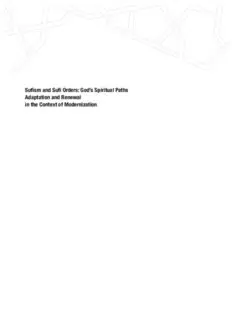
Sufism and Sufi orders : god's spiritual paths ; adaption and PDF
Preview Sufism and Sufi orders : god's spiritual paths ; adaption and
Su(cid:2)sm and Su(cid:2) Orders: God’s Spiritual Paths Adaptation and Renewal in the Context of Modernization Su(cid:2)sm and Su(cid:2) Orders: God’s Spiritual Paths Adaptation and Renewal in the Context of Modernization Hassan Abu Hanieh December 2011 Published in 2011 by Friedrich-Ebert-Stiftung Amman Of(cid:2)ce P.O. Box 926238, Amman 11110 - Jordan www.fes-jordan.org, [email protected] © Friedrich-Ebert-Stiftung, 2011 All rights reserved. No part of this publication may be reprinted or reproduced or utilized in any form or by any means without permission in writing from the publishers. Not for sale. Printing: Economic Printing Press, Amman, Jordan Translation and Editing: Mona Abu Rayyan Design and layout: Maya Chami, Beirut, Lebanon ISBN: 978-9957-484-15-6 Contents Introduction ......................................................... 9 Springs of Origin, Emergence and Foundation ............................. 17 Etymology and Origins of the Name, Terms and Definitions ....................................... 25 Causes, Motivations and Inspirations ............. 33 Islamic Sufism’s Historical Formation ............ 41 The Sufi Approach: Wisal and Wusul .............. 53 Mahabba and Fana’ ......................................... 65 Ways of the Path and the Order ....................... 81 Proliferation of the Paths of God ..................... 91 Sufi Orders in Jordan ...................................... 113 First: The Shadhili Order ................................... 123 I. The Shadhili-Darqawi-Hashimi Order ............. 126 II. The Shadhili-Darqawi-Hashimi- ‘Alawi-Filali Order .............................................. 135 III. Shadhili-Yashruti Order ................................ 138 IV. The Shadhili-Ghudhu(cid:2)-Qadiri Order ............. 142 Second: The Rifa’i Order ................................... 146 Third: The Rawasi-Rifa’i Order .......................... 150 5 Fourth: The Qadiri Order ................................... 153 Fifth: The Kasnazani-Qadiri Order ..................... 157 Sixth: The Khalwati Order ................................. 159 I. The Khalwati-Jami’a-Rahmani Order ............. 162 II. The Khalwati-Jami’a-Qasimi Order ............... 164 Seventh: The Naqshbandi Order ....................... 166 I. The Naqshbandi-Haqqani Order .................... 169 II. The Naqshbandi-Kilani Order ........................ 172 Eighth: The Tijani Order ..................................... 175 Politicization and Accessibility: Spiritual and Temporal .................................... 179 Conclusion ...................................................... 207 Endnotes ......................................................... 215 6 Introduction Jordan’s evolution, cultural narrative and religious history have been an inseparable part of the historical, intellectual and ideological development of both the Arab and the Islamic worlds. As a country, Jordan has been burdened by the same set of circumstances and conditions that affected other Arab and Islamic countries; and, historically, it was subjected to the same set of circumstances and conditions these other countries were during the formation of its national identity. Su(cid:2)sm is considered to be one of the components that constitute the Jordanian identity, as it is one of the major spiritual manifestations of Islam. This is especially the case as Su(cid:2)sm represents a current that intersects with the tenets and the fundamentals embraced by all religions. Certainly, it is a practice that has imprinted itself on the folds of human experience. During the earlier period of Islam’s inception, Su(cid:2)sm emerged as a spiritual revolution which aimed at reforming the nafs1 (the appetitive soul, corporeal self), disciplining it and purifying it2 of its vices and imbuing it with virtues in order to attain complete iman (faith) and the rank of ihsan3, and working towards the spiritual requirements of the Hereafter. It was a religious movement whose legitimacy was grounded in its religiosity and in its derivation from the fundamental and founding Islamic references, the Holy Qur’an and the Prophet’s Sunna4, which call for zuhd5 (asceticism) in the corporeal world, piety in one’s devotion to God and salvation in His worship. 9 The circumstances surrounding the birth of Su(cid:2)sm were not merely religious but rather included certain political, social and cultural factors. Historically, Su(cid:2)sm would evolve within an environment rife with the chaos, discord, strife and internal wars suffered by dar al-Islam6 in its earlier periods. The prevailing state of affairs led to spiritual crises, social injustices and obscene disparities in wealth between classes which, in turn, inspired individuals to seek out the development and the nurturing of a spirit of piety and asceticism. Thus, in its infancy, or at the turn of the 7th century AD, Islamic Su(cid:2)sm would emerge as a phenomenon characterized by an individual, unique and elitist nature. It would later evolve into a more popular, social manifestation in the 11th century AD with Su(cid:2) turuq (orders) taking root amongst the masses during the 17th century AD, or during the reign of the Ottoman state, which internalized and adopted Su(cid:2)sm ideologically. Indeed, it would never have been possible for Su(cid:2)sm to (cid:3)ourish the way it did without the support and patronage of the governing authorities, and the reign and stability of the ruling elite could not have been maintained and preserved without the support of Su(cid:2)sm, with a formula of “loyalty/patronage” generally governing the relationship between the two sides. However, during different periods in history, this formula was not always sustainable and the political conduct of Su(cid:2) orders would (cid:3)uctuate between postures of opposition and of loyalty. Nevertheless, and despite these political (cid:3)uctuations, Su(cid:2)sm would never become embroiled in con(cid:3)ict or take on a tradition of confrontation with the ruling authorities. As was the case with all the other areas in the Arab and Islamic worlds, Jordan would also experience the widespread proliferation of Su(cid:2) orders and Su(cid:2) zawaya7. Indeed, the (cid:3)uidity and freedom of movement during the reign of the Ottoman state allowed for different Su(cid:2) groups and practicing Su(cid:2) families to move from area to area, with many of these from Iraq, Syria, Palestine and Anatolia settling in Jordan, including the Rifa’i, Zughbi, ‘Amri, Rababa’a, Mustarihi, Mulqawi, Samadi, Kilani and Ja’ai(cid:2)rah groups and families, amongst others. 10
